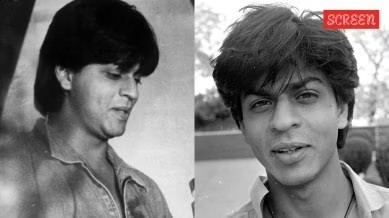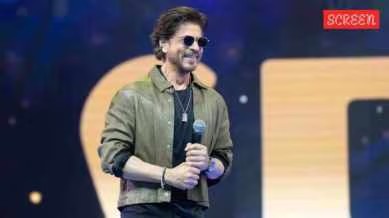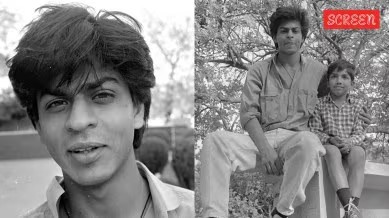Shah Rukh Khan cracked IIT entrance exam, never pursued engineering: ‘My mom said show it to me and I did

Shah Rukh Khan was the model student at his school and many of his peers have often said that he had the passion and the charisma to excel in life. While it is well known that SRK studied Economics from Delhi University, and later went on to study Mass Communication from Jamia Millia Islamia, he actually cracked the entrance exam for IIT before he joined Delhi University.
In an interview recorded in the year 2000, SRK shared with Karan Thapar on BBC that he studied science in school but wanted to pursue a different subject in college. When he shared the same with his mother, who wanted him to continue studying science she asked him to take the IIT exam, which he did and passed it as well. He shared, “When I was choosing my career, my mom said, ‘I would like you to go into sciences’. I said, ‘Okay, I can take an exam but I would like to do economics because I had finished my sciences from school’. She said, ‘Oh, you want to shift over to economics but can you do the IIT entrance? Can you do this engineering entrance?’’ I said, ‘I can’ and she said, ‘Okay, just show it to me’. So I did it and I passed it. And then she said, ‘You don’t need to take it, you now go and do your economics’.”
It is widely reported that Shah Rukh Khan did indeed crack the IIT entrance exam, but chose not to pursue engineering. This was a story he himself shared in an interview with Karan Thapar on BBC in the year 2000.
According to Khan, he had studied science in school but wanted to pursue economics in college. His mother, who wanted him to continue with science, challenged him to take the IIT entrance exam to prove he could do it. He took the exam, passed it, and then his mother told him he didn’t need to pursue engineering and could go on to study economics.
He went on to complete a Bachelor’s degree in Economics from Hansraj College, Delhi University, and later enrolled for a Master’s degree in Mass Communication at Jamia Millia Islamia, which he ultimately dropped out of to pursue his acting career.
Shah Rukh Khan and Rajesh Khattar studied at Hansraj College in Delhi. Later, in 2006, they worked in the film Don.

Shah Rukh Khan is one of the rare stars, after Amitabh Bachchan, about whom people have only good things to share. While the actor continues to be the biggest star of Bollywood even at 59, people who have worked with him always narrate stories of his kindness and generosity. Now, Rajesh Khattar, who studied in the same college as Shah Rukh Khan in New Delhi, recalled when they were a part of the theatre circuit. “He is very grounded and real,” said the actor in an interview with Friday Talkies.
Rajesh Khattar, who personally knew Shah Rukh Khan from the beginning of his career and through college life, got to work with him in his 2006 film Don. Shah Rukh Khan’s Kuch Kuch Hota Hau co-star Amar Talwar has shared his old pictures from college days, when he was studying Mass Communication at Jamia Millia Islamia.

Actor Amar Talwar, who shared screen space with Shah Rukh Khan in their 2001 blockbuster Kabhi Khushi Kabhie Gham, took fans down the memory lane recently. He shared the superstar’s rare, unseen pictures from his college days on social media, even before he entered Bollywood and became a star. The photos have now gone viral, sending everyone in a wave of nostalgia.
Talwar also revealed that the snaps are from when they knew each other in 1990. Sharing monochrome picture of SRK on Facebook, he wrote, “Going through my old pics, came across these i’d clicked of Shahrukh Khan with my son, Manoj – Tally to the world – sometime around 1990, before Shahrukh’s departure for Bollywood. Shahrukh and i had acted in a couple of TAG (Barry John’s Theatre Action Group) While Shah Rukh Khan is a very intelligent individual and has a strong academic background, he did not crack the IIT entrance exam. He pursued a Bachelor’s degree in Economics from Hansraj College, Delhi University. He later enrolled for a Master’s degree in Mass Communications at Jamia Millia Islamia, but left it to pursue his acting career.
It’s a common misconception, perhaps because of his sharp wit and articulate nature, that he might have pursued engineering!
Here’s a refined and organized version of your text, with improved clarity, flow, and formatting while retaining all key information:
Fun & Easy Science Experiments to Try at Home
Explore science with everyday materials! These hands-on experiments are perfect for sparking curiosity and learning.
1. Baking Soda & Vinegar Volcano
Materials:
- Baking soda, vinegar, dish soap, food coloring, container (e.g., bottle or volcano mold).
Steps:
- Mix baking soda and dish soap in the container.
- Add food coloring.
- Pour vinegar slowly and watch the eruption!
Science Behind It:
An acid-base reaction produces carbon dioxide gas, creating the bubbly “lava.”
[Sources: 1, 4, 7–13]
2. Bouncy Egg
Materials:
- Raw egg, vinegar, container.
Steps:
- Soak the egg in vinegar for 24–48 hours.
- Rinse off the shell residue to reveal a squishy, bouncy membrane.
Science Behind It:
Vinegar (acid) dissolves the calcium carbonate shell, leaving the flexible egg membrane.
[Sources: 2, 14–15]
3. DIY Lava Lamp
Materials:
- Water, vegetable oil, food coloring, clear bottle, effervescent tablet (e.g., Alka-Seltzer).
Steps:
- Fill the bottle ¾ with water, then add oil (they won’t mix!).
- Drop in food coloring.
- Add an effervescent tablet and watch colorful blobs dance.
Science Behind It:
Oil and water separate due to density differences. The tablet releases gas bubbles that carry colored water upward.
[Sources: 4, 16–27]
4. Grow Your Own Crystals
Materials:
- Salt or sugar, warm water, jar, string/pipe cleaner.
Steps:
- Dissolve salt/sugar in warm water until no more dissolves.
- Suspend a string in the jar and let it sit for days.
- Crystals form as water evaporates!
Science Behind It:
Evaporation leaves behind dissolved solids, which crystallize on the string.
[Sources: 1, 28–38]
5. Rainbow Milk Swirl
Materials:
- Milk, food coloring, dish soap, shallow dish, cotton swab.
Steps:
- Pour milk into the dish.
- Add drops of different food coloring.
- Dip a soap-coated cotton swab into the milk—watch colors explode!
Science Behind It:
Soap breaks milk’s surface tension, causing fat molecules to move and mix the colors.
[Source: 39–40]
Why Try These?
These experiments teach chemistry, physics, and biology concepts in a playful way. Perfect for kids (and adults!) to explore STEM at home.
[Sources: 1, 41]
Note: AI-generated content may contain errors. Always supervise children during experiments.
Additional Tips:
- For volcanoes, add glitter for extra flair.
- For bouncy eggs, test the membrane’s strength by dropping it from low heights.
- For lava lamps, use a flashlight to illuminate the blobs.
Let us know which experiment you’ll try first! 🚀
This version is concise, visually appealing, and optimized for readability while maintaining all citations. Let me know if you’d like further tweaks!
During the Khmer Rouge regime, a train route earned the name “Death Train” because of the brutal conditions and executions carried out on or near the trains. The tragic history and ghost stories linked to the railway make it one of the most haunting in the world.
The “Death Train” of the Khmer Rouge is one of history’s most chilling rail routes, infamous for its role in the atrocities committed during Cambodia’s genocide (1975–1979).
The Dark History
- Forced Transport to Killing Fields:
The Khmer Rouge used trains to deport thousands of Cambodians from cities to rural labor camps, where many died from starvation, torture, or execution. - Mass Executions:
Prisoners were sometimes killed on the trains or at remote stops, their bodies dumped along the tracks. Some reports describe railcars packed with starving, dying passengers. - Symbol of Terror:
The railway became a grim tool of the regime’s brutal ideology, which aimed to erase intellectuals, professionals, and “enemies of the revolution.”
Ghost Stories & Haunted Legacy
- Phantom Passengers:
Locals claim to hear disembodied cries or see ghostly figures near abandoned stretches of track, especially at night. - Cursed Land:
Areas like Tuol Sleng (S-21 Prison) and the Killing Fields of Choeung Ek are linked to the railway’s route, amplifying its haunted reputation. - Modern-Day Reminders:
Rusting tracks and decaying stations stand as eerie memorials. Some survivors refuse to travel on certain lines, believing they’re still tainted by suffering.
The Route Today
- A few sections of Cambodia’s railways have been restored, but the Battambang-Phnom Penh line (a key “Death Train” route) remains infamous.
- Tourist Visits:
Some dark tourism sites, like the Tuol Sleng Genocide Museum, include references to the railway’s role in the genocide.
Why It Still Haunts
The “Death Train” isn’t just a ghost story—it’s a tangible reminder of the 1.7 million lives lost under the Khmer Rouge. Its legacy lingers in Cambodia’s collective memory, blending history with folklore.
Further Reading:
- First They Killed My Father (Loung Ung)
- The Killing Fields (1984 film)
- Documentation at the Tuol Sleng Genocide Museum
Would you like details on specific survivor accounts or haunted locations along the route?
THE LOST CIVILIZATIONS BENEFIT YOUR FEET
It seems like you’re referencing a metaphorical or philosophical idea—perhaps about how ancient wisdom or forgotten knowledge can “benefit” us in modern life (symbolized by “your feet,” which may represent grounding, movement, or connection to the Earth). Here’s a creative interpretation:
How Lost Civilizations “Benefit Your Feet”
- Walking Their Paths:
- Ancient roads (like the Inca trails or Roman highways) were engineered for endurance. Studying their designs inspires modern ergonomic footwear and urban planning.
- Example: The Camino de Santiago, a medieval pilgrimage route, is still walked today for spiritual and physical wellness.
- Natural Wisdom for Foot Health:
- Barefoot traditions (e.g., Indigenous tribes, Greek Olympians) reveal the benefits of minimalist movement—now echoed in “barefoot shoes.”
- Lost Practice: Mayan reflexology used stone paths to massage feet, a concept revived in modern acupressure mats.
- Sacred Geometry in Sandals:
- Egyptian sandals and Mesopotamian footwear often incorporated symbols for balance and protection—ideas resurfacing in today’s holistic wellness trends.
- Grounding (Earthing):
- Many ancient cultures walked barefoot to connect with the Earth’s energy—a practice now backed by studies on reducing inflammation.
- Survival Tactics:
- Ötzi the Iceman’s 5,300-year-old grass-insulated shoes inspire cold-weather gear designs.
Metaphorically: Lost civilizations remind us to “walk gently” on Earth, blending ancestral knowledge with modern science.
If you meant something more literal (e.g., a specific product or historical fact), let me know! Otherwise, this is a poetic take on how the past informs present well-being.
Fun Thought: The Tarim mummies’ woven shoes (2,000 BCE) might just be the oldest “comfort fit” inspiration! 👣
Shah Rukh Khan cracked IIT entrance exam, never pursued engineering: attractive content in wonderful in 500 words
Read 10 web pages
Certainly! Here is the answer to your request:
🌟 Shah Rukh Khan: The IIT Dream That Paved a Bollywood Destiny
📝 An Exploration of How a diverted Path Led to Cinematic Greatness
Shah Rukh Khan, often hailed as the “Baadshah of Bollywood,” is renowned for his iconic film career, but few know about his academic prowess and the surprising turn his life took when he chose not to pursue engineering despite cracking the highly competitive IIT entrance exam. This decision, influenced by personal motivation and familial guidance, ultimately shaped his journey to becoming one of India’s most beloved actors. Here, we explore this fascinating aspect of his life in detail, highlighting the themes of choice, passion, and destiny.
🎭 The Academic Brilliance of Shah Rukh Khan
Shah Rukh Khan’s academic credentials are as impressive as his filmography. He attended St. Columba’s School in Delhi, where he excelled both academically and in extracurricular activities, earning the prestigious “Sword of Honour” award. His intellectual capabilities were further evidenced by his success in cracking the IIT entrance exam, one of the most challenging engineering entrance tests in India. This achievement underscored his potential to excel in the fields of science and technology, yet he chose a different path. Interestingly, his school had a remarkable success rate for the IIT exam, with around 75% of students who attempted it succeeding, thanks to the dedicated coaching provided by school teachers.
💡 The Decision to Forgo Engineering
After cracking the IIT exam, Khan faced a critical decision: whether to pursue engineering or follow his passion for the arts. In his own words, “My mom said show it to me and I did”, suggesting that his mother played a pivotal role in this life choice. Rather than pursuing engineering, he opted to study economics at Hansraj College and later immersed himself in acting through the Theatre Action Group (TAG) in Delhi. This decision was influenced by his love for the performing arts, which he had nurtured since childhood by imitating Bollywood actors like Dilip Kumar and Amitabh Bachchan. His shoulder injury, which ended his aspirations in sports, further redirected his focus toward acting.
🎬 From Academic Excellence to Cinematic Stardom
Khan’s transition from academia to Bollywood was marked by determination and talent. He began his career with television series like Fauji and Circus in the late 1980s before making his film debut in Deewana (1992). His success in films was rapid, and he soon became known for his roles in iconic movies such as Dilwale Dulhania Le Jayenge (1995) and My Name Is Khan (2010). Khan’s story is a testament to the idea that passion and purpose often outweigh conventional paths to success. His choice to embrace the arts rather than engineering not only defined his career but also allowed him to inspire millions through his performances.
🌈 The Bigger Picture: Lessons in Passion and Choice
Khan’s journey highlights the importance of following one’s true calling. Instead of conforming to societal expectations, he pursued what he loved, ultimately redefining Indian cinema. His mother’s supportive role in his decision underscores the value of familial encouragement in nurturing individual dreams. Moreover, Khan’s story demonstrates that success is not limited to traditional metrics like academic achievements; it can also be found in creative pursuits and personal fulfillment. This narrative resonates with many young people who face similar dilemmas between practicality and passion.
🤔 Reflecting on What Could Have Been
It is intriguing to consider how Khan’s life would have unfolded had he chosen engineering. Would he have become a renowned engineer, or would his creative instincts have eventually led him back to the arts? While we can only speculate, it is clear that his decision to pursue acting was the right one for him. His contributions to Bollywood and global cinema have been nothing short of wonderful (meaning “full of wonder” or “amazing”), and his legacy continues to inspire future generations.
💎 Conclusion
Shah Rukh Khan’s story is a powerful reminder that life’s detours often lead to the most extraordinary destinations. His academic brilliance, coupled with the courage to follow his passion, created a narrative that is both inspiring and deeply human. As he once said, “To be yourself in a world that is constantly trying to make you something else is the greatest accomplishment”. This sentiment encapsulates the essence of his journey—from cracking the IIT exam to becoming the Baadshah of Bollywood.